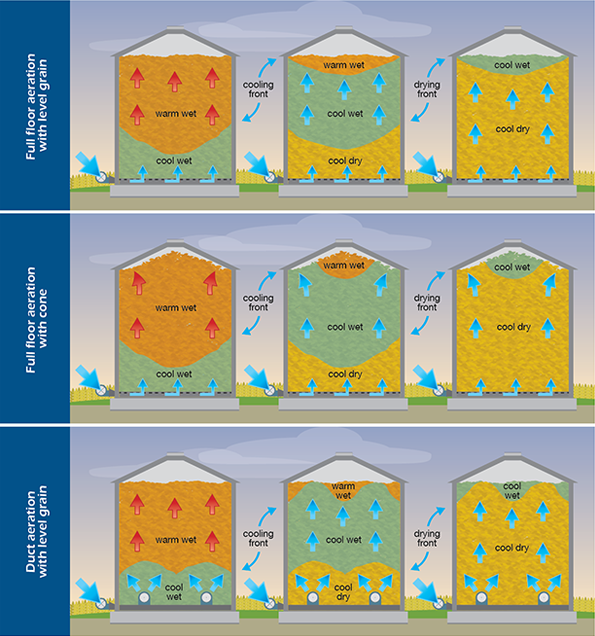Aeration is the stored grain management technique of forcing cool air at low airflow rates through the grain mass in order to equalize the grain temperature and in the process effect cooling. Aeration is the transfer of high volumes of cold air through a grain mass.
The purpose of aeration is:
- To achieve homogeneous moisture throughout the product in the silo.
- To achieve homogeneous temperature throughout the product in the silo.
This is generally the most effective method to maintain grain quality without having to move the grain.
The Benefits of Moving AIR Rather Than GRAIN
- Lower kWh consumption (reduced power costs).
- No grain damage since there are no breakages and seed quality is maintained.
- Lower maintenance costs.
- Reduce insect infestation.
- Elimination of hot spots.
Aeration removes the moist air from the grain and thereby achieve a homogenous moisture and temperature. Temperature and humidity play a large role in aeration. Air that is at a lower temperature than the grain, will cool the grain off, not just to the air temperature, but to the wet ball temperature of the air. Usually the grain loses a small amount of moisture during the cooling phase of aeration. Aeration thus cools the grain and also reduces the moisture content slightly. Any heat that is caused by respiration is removed and hot spots are thus eliminated.
Before aeration is commenced, the properties of air in respect to temperature and relative humidity must be conducive so that no wetting of grain occurs. In this respect there are automatic aeration devices, if desired.
- The top silo vents, hatches and manhole covers should be opened to discharge the air out of the bins.
- During aeration exhaust air and grain surface are monitored to determine when cooling is complete.
- Aeration must be carefully controlled to prevent wetting of the grain and introduction of insect pests.
- Plant operator maintains record of the activity on the prescribed format.
The purpose of aeration is not to use the aeration system as a dryer to dry grain. Although a degree of drying can take place in ideal conditions, it is still limited, and the main objective is to prevent heat accumulation of grain due to biological actions taking place. Air which has a lower temperature of at least 6°C as that of the grain, will cool the grain down, not only to the air temperature, but also to the wet bulb temperature in the air.
The cold, dry air will absorb the grain’s temperature and thus also remove some moisture. When this air is vented, not only will heat but also moisture be removed from the grain.

Aeration Systems
Aeration systems preserve stored grain and keep it dry by reducing the temperature of grain and reducing moisture migration. Appropriate aeration can prevent convection currents and condensation from occurring.

It is important to consider the physical characteristics of grain when considering aeration and drying. Factors such as grain class and storage configuration impact the static pressure and thus the aeration fan requirements. In general, as static pressure increases (e.g. increased height of the storage or change in the class of commodity in storage), the amount of time required to properly aerate also changes.
Aeration equipment design is rather complex and must be considered as a “system". An aeration system includes the fans, the ductwork or perforated flooring, the passive and/or powered vents, the grain, the air being moved through the grain and the controls (either electronic or manually operated). Careful attention must be paid not only to the design of this system, but also to the proper timing and control of the aeration system.

Click here to view a video that explains airflow principles.